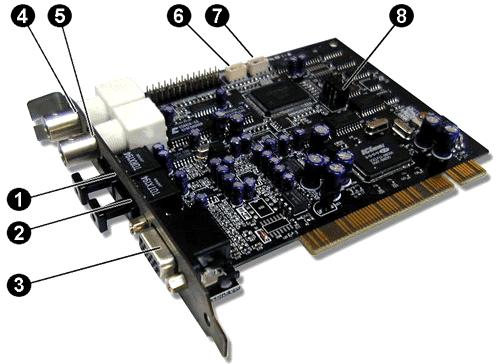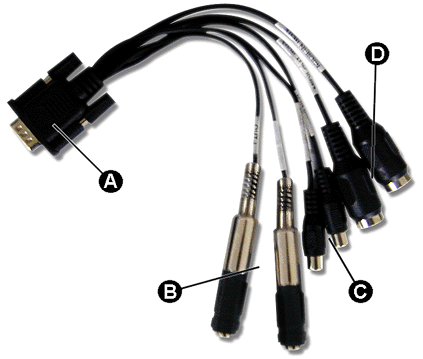
DSP24 ADAT connector layout
This text describes the connectors of the DSP24 ADAT PCI-card. The photo shows the PCI-card and its layout:

| 1 - | optical ADAT input (8 audio channels) | |
| 2 - | optical ADAT output (8 audio channels) | |
| 3 - | connects to the breakout cable (15pin D-SUB to RCA / TRS adapter) - see below | |
| 4 - | BNC WordClock input | |
| 5 - | BNC WordClock output | |
| 6 - | analog CD input (routed to the Internal Mixer [1]) – CON1 | |
| 7 - | analog Aux input (routed to the Internal Mixer [1]) – CON2 | |
| 8 - | Jumper settings for further configuration - see below |
Here is description of the connectors on the breakout cable that is included with the DSP24 ADAT:

| A - | 15pin D-SUB connector that connects to the DSP24 ADAT PCI-card | |
| B - | analog monitoring outputs (1/4" TRS unbalanced –10dBv, left and right channels) | |
| C - | coaxial S/PDIF in- and output (RCA) | |
| D - | MIDI in- and output (DIN) |
Using the WordClock in-/output
When used in a professional studio envrionment that is using WordClock synchronisation, the DSP24 ADAT can send out WordClock sync signals and also use the clock from other WordClock devices.
 To
use the WordClock output, connect the corresponding cable to the WordClock output
BNC connector. It will always send out the sample rate that is selected by the
software using the DSP24 ADAT.
To
use the WordClock output, connect the corresponding cable to the WordClock output
BNC connector. It will always send out the sample rate that is selected by the
software using the DSP24 ADAT.
In order to sync the card to other WordClock devices, you need to configure the DSP24 ADAT by changing a jumper on the hardware itself.
 The
picture on the right side shows the jumper block in it's default and recommended
setup. All jumpers on HD5 to HD2 are set to OFF.
The
picture on the right side shows the jumper block in it's default and recommended
setup. All jumpers on HD5 to HD2 are set to OFF.
If you are not using the WordClock input, do not change this!
The settings shown on the left side enable the WordClock input. The HD5 jumper is now set to ON. The other jumpers (HD4, HD3 and HD2) are untouched.
To sync the DSP24 ADAT card to an external WordClock source, External Links [2] must be set to ADAT synchronisation (more details on this can be found in the printed documentation that you received with your DSP24 ADAT card).
|
|
last updated: 10/28/2001 author: Claus Riethmüller
|
|
| References to other documents or external websites |
|
[1]
The Internal Mixer,
ST Audio Knowledge Base
[2] How to use External Links, ST Audio Knowledge Base |
|
|